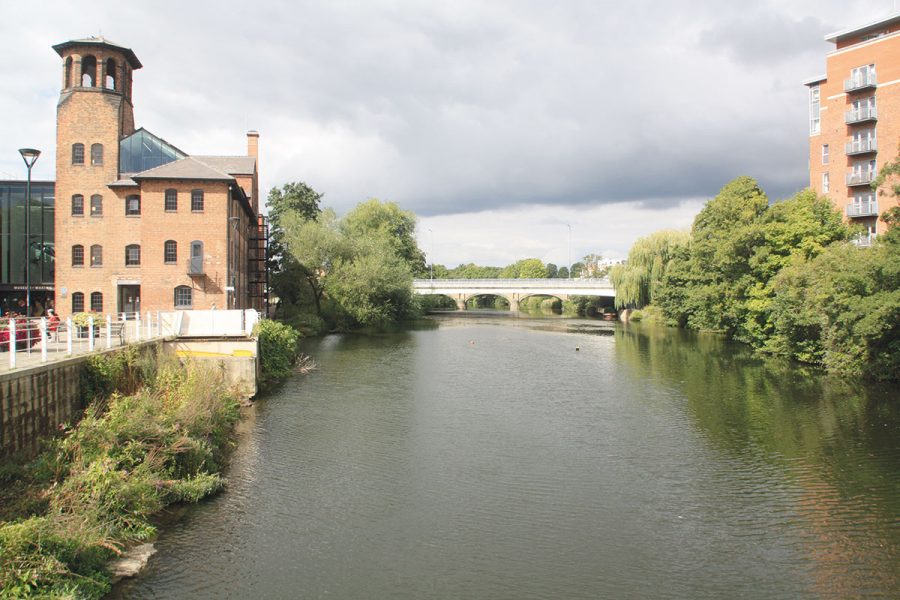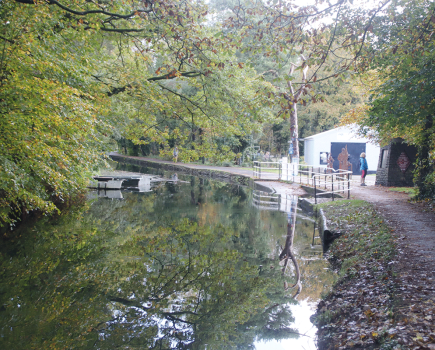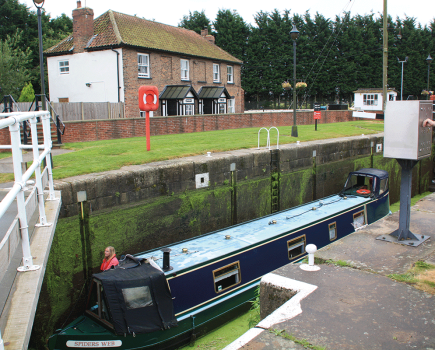Putting a trip-boat on a nearby river and rebuilding a derelict set of cottages might not seem like the obvious way forward for a group planning to reopen a long-abandoned canal. But it seems to be getting things moving on the Derby Canal, as Martin Ludgate finds out…
Reopening the Derby Canal through from the junction with the Erewash Canal at Sandiacre via Derby city centre to the Trent & Mersey Canal at Swarkestone isn’t going to be the easiest of canal restoration projects. The middle section of this upside-down L-shaped canal has been lost under the city of Derby – there are missing motorway, main road and railway crossings to be dealt with – and sections of the canal have been filled in.
But away from these areas there are lengths which will be more straightforward to restore, on both the Derby to Sandiacre (‘eastern’) length and the Derby to Swarkestone (‘southern’) section. The Derby & Sandiacre Canal Trust has already had a considerable amount of success in restoring structures and sections. There looks to be more success stories on the way, and the Trust has interesting and ambitious plans for dealing with the major challenges.
In that context, it therefore might seem odd that neither of its two main recent efforts have been directly concerned with physical restoration of the historic canal at all. But as Chairman Chris Madge explains to me, indirectly they are both crucial in making progress towards the eventual goal of full reopening.
CANALSIDE COTTAGES
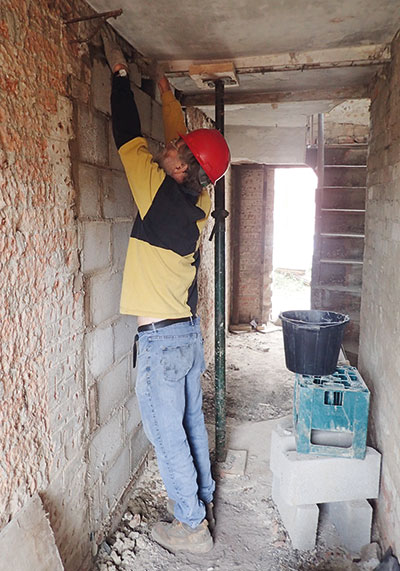
The author working as a volunteer on renovating the Draycott canal cottages
The first of these projects is a terrace of canalside cottages at Draycott, roughly halfway along the eastern section of the canal between Derby and Sandiacre. These have an interesting history, having started life as a textile mill in 1815. When the mill moved into larger premises, the building was converted into a set of canal workers’ cottages, only to later be converted once again to a smaller number of rather larger cottages.
The major changes involved (with new walls added and old ones removed) wouldn’t exactly have met modern building standards; this and 30 years’ neglect after they fell into disuse meant that the building was in a parlous state when a developer offered it to the Canal Trust for around £175,000 in 2016. There were holes in the floors and ceilings, in places it was only the rotten floors that were holding the poorly constructed walls together, vegetation had taken root and there was an ash tree on the roof.
So why did DSCT buy it? Firstly it was the last significant recognisably canal-related building on the entire route; secondly the Trust felt that if restored it could be put to good use to help the canal restoration. Five years’ work saw initial vegetation clearance by Waterway Recovery Group’s specialist forestry volunteers, the frontage taken down and rebuilt, walls repaired and underpinned, water and drains installed and the building redecorated.
The result is a set of three cottages, plus a café, meeting room and museum room. Or, as DSCT sees it, three homes providing a useful rental income to support further canal restoration work, plus a useful facility that forms a link between the Trust and the local community, attracts new volunteers, gives the Trust credibility and could provide equity if money needs to be borrowed to fund restoration work. Already the local authorities along the route, some of which had an attitude of “it’ll never happen”, have become more supportive of the canal.
It wasn’t cheap – in fact Chris Madge calls it “a massive drain on our resources”. But he reckons it’s been worth it.

BOAT TRIPS
The second recent project is to put a public trip-boat in operation on the River Derwent, based in the centre of Derby. Over a year’s design work went into making Outram (named after the canal engineer Benjamin Outram) as environmentally friendly as possible, with an electric propulsion system getting part of its power from solar panels.
The £400,000 project was supported by Derby Council and the boat was launched in autumn 2021. A limited weekend passenger service was launched in August 2022, with more crew being trained up to enable a full service to be operated in the future. Initial operation was from a boarding platform, but once upgraded to a pontoon (to be known as the Phoenix Boat Station) it will be possible for wheelchair passengers to board the fully accessible craft with its onboard lift. The trips run upstream from the Causey Bridge in the city centre to Darley Abbey and back. An onboard commentary is provided covering Derby’s history and the Trust’s plans for the future. And speaking of those plans…
If you’re familiar with the Derby Canal’s history, you’ll realise that once again this project doesn’t relate directly to the restoration of the historic canal, whose original main line didn’t make use of the river other than to cross it on the level in the city centre.
However, the loss of the lengths of canal on either side of this river crossing mean that the restoration will take a different approach. As the eastern section of the canal from Sandiacre arrives on the outskirts of the city, the plan is for it to turn southwest at Spondon to follow a new course, crossing the river on an aqueduct to reach Wilmorton, where it will rejoin the original route of the southern length of the canal to Swarkestone.
This would re-create the canal’s function as a through route from the Erewash Canal to the Trent & Mersey Canal, but it would be a huge lost opportunity if it failed to serve the centre of Derby at all. So the Trust’s plan is that an alternative route into the city centre will be created, by using a length of the river. And the canal will be connected to the river by what’s been christened the ‘Derby Arm’, a spectacular boat lift built adjacent to the new aqueduct over the river. From there, boats will cruise for a mile into central Derby, climbing a new lock built alongside the city centre weir.
PLAN COMES TOGETHER
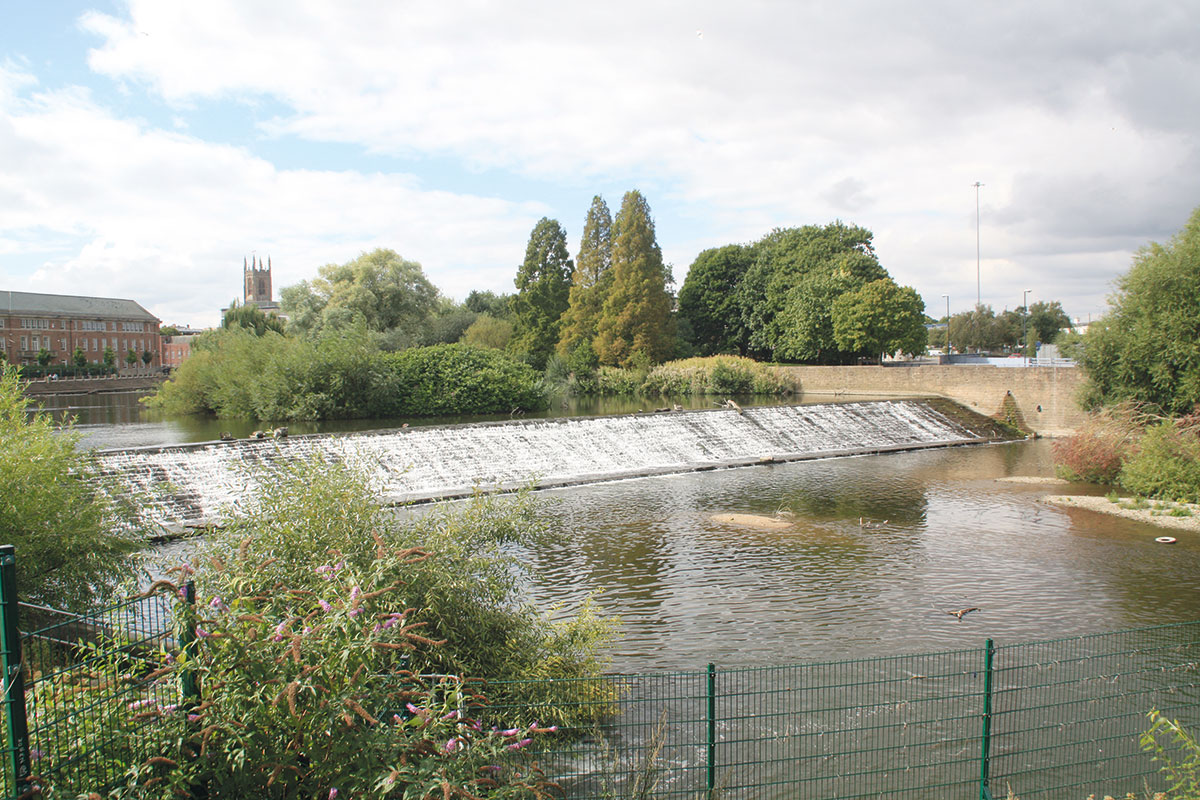
The plan is to build a lock at the right-hand end of the weir in Derby to extend the navigable length of river east of the city
And that’s where the trip-boat operation begins to make sense. Initially it will operated on the length upstream from the weir, but the aim is that the publicity that it provides will support the case for building the weir lock, making the river navigable downstream from there, building the boat lift and creating the canal diversion length.
That sounds like a lot of expensive work – and it is. Even the planning and preliminary work is estimated to cost somewhere in the region of £15m. The good news is that provisionally it looks like it will provide the two-to-one benefit to cost ratio that’s needed for it to attract support from the Government’s Levelling Up Fund – which is seen as the best chance of getting it funded. The full construction cost could be £50m.
And for all its regeneration and tourism benefits to the city, it’s still an isolated section of waterway with no connection to the outside world. As Chris Madge says: “If this is to really work it needs boats from either the east or the south.”
The Trust’s view is that both the cottages and the initial trip-boat operation give credibility and visibility to the restoration. Extending it via the new lock and boat lift give it more impact. But linking it either to the Trent & Mersey or the Erewash (and eventually to both) will mean it really starts to make sense.
So at last, we can talk about some actual canal restoration, because there’s progress on both lengths of canal.
CANAL RESTORATION
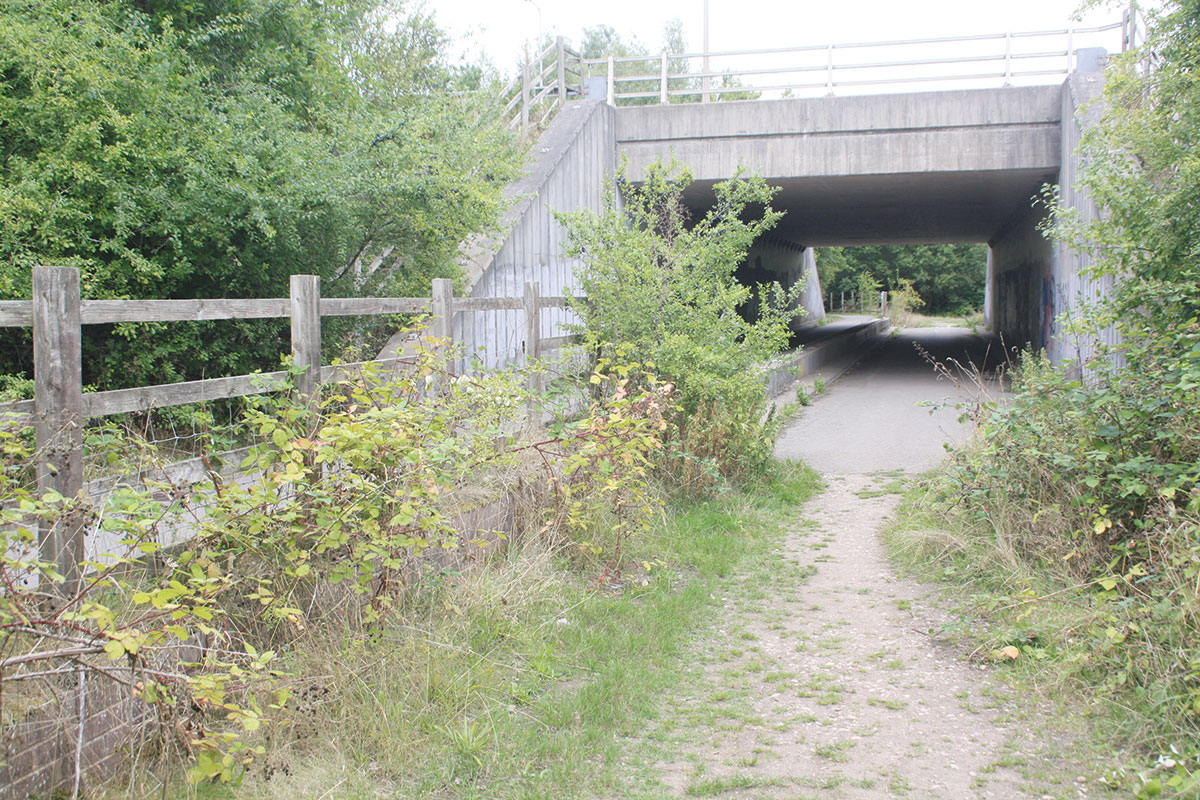
The canal will be diverted through this disused farm crossing under the A50 at Swarkestone
Dealing first with the southern length, from Derby to Swarkestone Junction on the Trent & Mersey, this progress is centred around a planned housing development near the south end. Here, the canal was dealt a serious blow some 25 years ago when the new A50 dual carriageway came through with no provision for the canal.
That might sound like a show-stopper, but very conveniently there’s a bridge nearby carrying the road over a cycleway and a former farm crossing that’s no longer needed – so the restored canal could be diverted through it. It’s at a lower level, meaning that the canal would leave the T&M at a new junction below Swarkestone Lock rather than above it as it originally did, and a new lock would be needed north of the A50 to return the canal to its original level.
That’s been DSCT’s plan for some years, but thanks to a planned housing development alongside the canal it looks like it will actually happen – because of the benefits the canal will provide:
• It can act as a ‘balancing pond’ for run-off water from the 5,000 new homes
• It would form an attractive water feature for the development
• The spoil excavated can help to build up the ground to build the houses on
• The canal could help carry any flood water away to the River Trent.
Oh, and one added bonus: the change to the canal level will help it to pass under the next road crossing northwards, where Infinity Park Way crosses the canal at a low level, but where the City Council has already agreed to fund a new bridge “when the canal restoration is in a position to get beyond it”.
At a stroke, that could get the canal through some of the trickiest problems on this southern length. The next main road bridge is still intact (you can walk through the remains of a lock immediately beyond it).
There’s a tricky crossing where the ring road cuts through the canal, but then London Road crosses on another surviving bridge. And then we’re onto the start of the diversion via the new Derwent aqueduct.
PROGRESS MADE
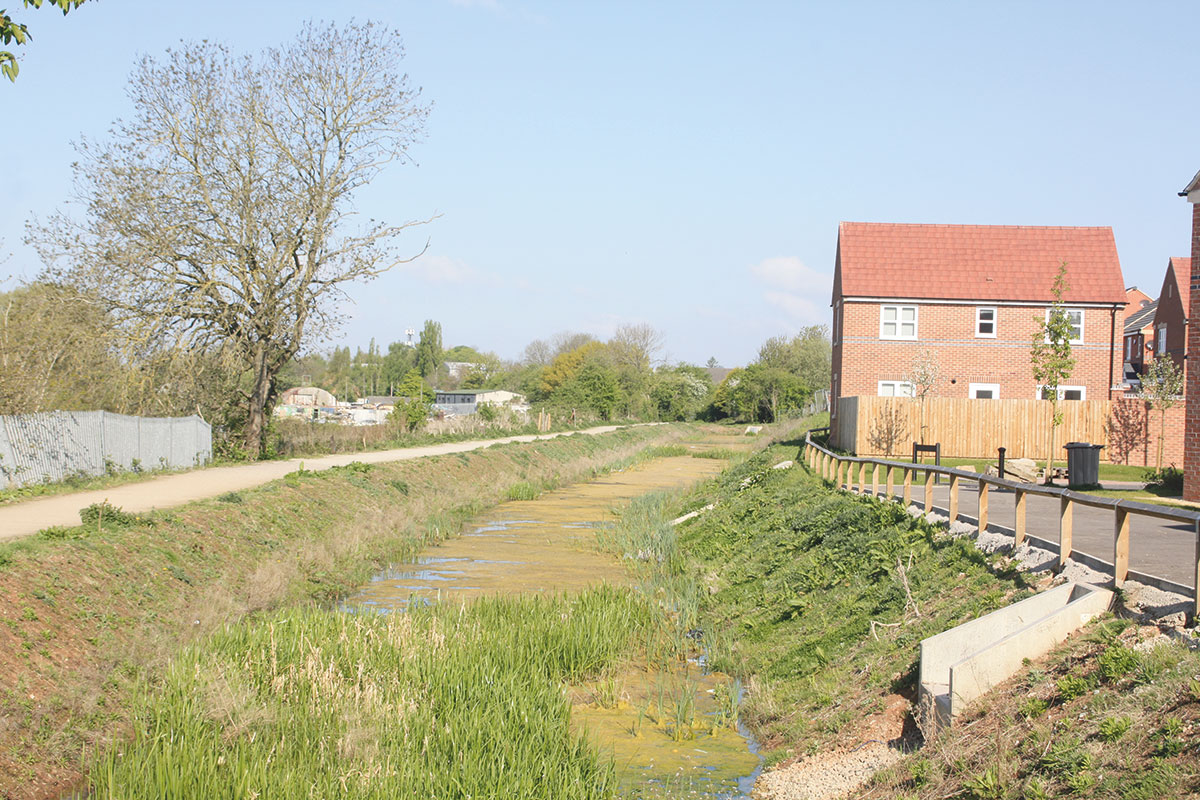
Length of channel reinstated as part of a housing development at Spondon
Now we’ll look at the eastern length, from Derby to the Erewash Canal at Sandiacre Junction. There’s been recent progress there too, with more on the way. Starting at the Derby end, on the outskirts of the city near Spondon a short section of canal has recently been re-created as part of another housing development. It’s a relatively modest 450m, but it set some useful precedents: the canal was used as an ‘attenuation pond’ for the housing, its existence as a feature appears to have helped to sell the new homes and it was done at no cost to the Canal Trust – the Council donated the canal land to the Trust and the developer paid for spoil disposal.
Heading further eastwards out of Derby (past a couple of surviving bridges), we next reach Borrowash Locks where the lower of the two locks has been completely rebuilt by volunteers including support from Waterway Recovery Group canal camps. It awaits gates, the diversion of a sewer and the Trust finding some way of getting water to the restored lock (which will involve the canal crossing a stream which currently cuts through it below the lock). Problems to be dealt with in this area also include a new bridge needed to carry Station Road, Borrowash over the canal – but the planned electrification of the adjacent railway (and therefore the need for a new higher railway bridge) may provide an opportunity.
An infilled length across fields (which will need some negotiation with the landowners) brings us to the A6005 bridge, a surviving 1930s concrete structure and to a 1km long section at Draycott which has been a focus of DSCT efforts. A 300m length has been excavated, the remaining 700m leading up to the restored canalside cottages is subject to discussions.
We’ll now skip to the far end of the eastern section of the canal, at Sandiacre where it meets the Erewash Canal. There has already been clearance work on the first lock by the junction, but further progress will involve moving a sewer which currently crosses between the lock’s wing walls. Following a similar approach on other canal restoration projects (for example Compasses Bridge on the Wey & Arun Canal) the Trust plans to keep the work done by professional contractors down to a bare minimum – basically the actual installation and connection up of the sewer pipe. All other work – surveys, soil samples, design, excavation and filling in the trench afterwards – will be done by the Trust’s volunteers. It’s all agreed, funded (thanks to a legacy) and work is set to begin within weeks.
CANAL OPTIONS
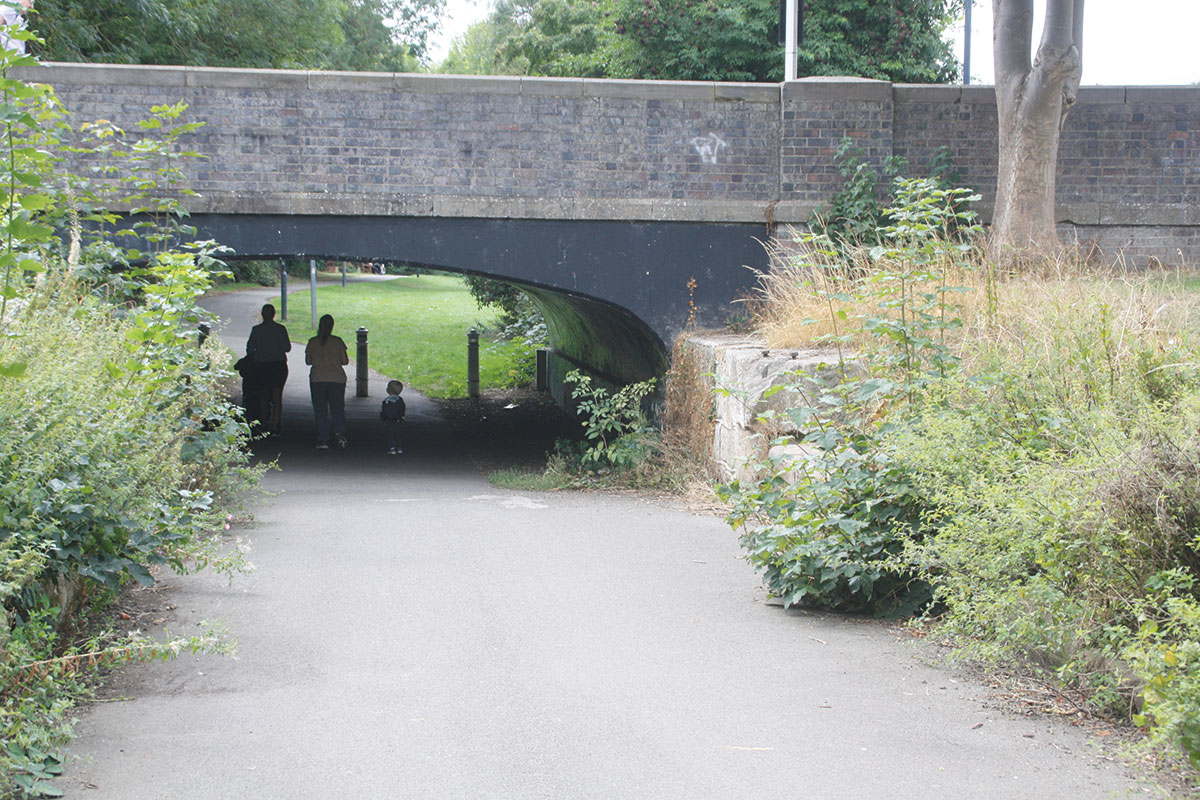
Surviving bridge and remains of the lock on the southern section of the canal
Heading west from there, it gets trickier. There’s a second lock, but decisions need to be made on whether it will be restored at all. It depends on the local authorities’ future plans for Bostocks Lane which crosses the canal at a low level, the original hump-back bridge having been demolished.
If the Council decides that Bostocks Lane is no longer needed as a through route, it will be acceptable to install a high level (or opening) bridge, restore the canal on its original level and restore the lock. If, on the other hand, the Council decides to retain Bostocks Lane as a through route, neither of those options for the bridge would be acceptable, so the canal will need to be lowered, and the lock abolished and replaced by a new one further west.
This decision may also impact the next section westwards, potentially the most serious blockage on the canal, where the M1 motorway crosses on an embankment. Options for reinstating it include either thrust-boring through the embankment (and perhaps an appeal to a National Highways fund for rectifying environmental damage from new roads built in the past, which has already supported canal restoration projects elsewhere), or squeezing the canal under an existing bridge alongside a road. The option chosen for crossing Bostocks Lane may well decide which of these is more practicable.
The remaining couple of miles between the M1 and Draycott are relatively straightforward. Two minor roads need to be crossed, and the channel is largely filled in, but some of the land has been acquired, and elsewhere a landowner is supportive.Summing up the attitude not just to this section but to the whole canal, Chris Madge says: “If you’ve got the intent behind it, all of these are engineering problems”.
We’re not going to suggest that this is a straightforward project or that it will be achieved quickly. But it does look like the Derby is set to make good progress in the coming years, thanks to a combination of volunteer work, taking advantage of adjacent developments, creating major attractions, appealing to a wide range of possible funding sources and raising the restoration’s profile with local communities and authorities.
And the fact that it’s getting under way is at least in part thanks to a trip-boat and some restored cottages.
To find out more about the canal restoration, to join the Canal Trust or to book a boat trip, see derbycanal.org.uk
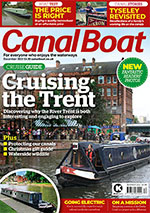 As featured in the December 2022 issue of Canal Boat. Buy the issue here
As featured in the December 2022 issue of Canal Boat. Buy the issue here

